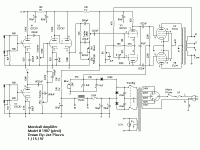Pins 1&8 of the tube socket should be tied to ground by a metal wire.
Remove it.
Install 1 ohm resistor from pins 1&8 to ground. (1/4 watt)
Measuring the voltage across this new resistor gives you current through the tube.
Example: 1mv = 1ma
Set it for 25mv.
Do this for all output tube sockets.
Remove it.
Install 1 ohm resistor from pins 1&8 to ground. (1/4 watt)
Measuring the voltage across this new resistor gives you current through the tube.
Example: 1mv = 1ma
Set it for 25mv.
Do this for all output tube sockets.
You might want to check out this site for a more in depth discussion of the whys and hows of biasing. The website is a little out there but the info is great: Tales From The Tone Lounge; Biasing a Marshall JCM800!
read the tone lounge article. There is no way I am going to use my 350 V rated scope probes (Smith OP2010) to measure plate current. My question is, my dynakit ST70 manual recommends bias for the 6CA7's at 100 ma cathode current, 50 ma x 2. My tubes wear out in about 8 years of 6 hours a day. Tone Lounge is recommending 36 ma plate current. MattyAve is recommending 25 ma. The EL34 is supposed to be interchangeable with the EL34. Why the difference?
25 ma may be good to your tubes, but it is guaranteed to develop major cross-over distortion as well. Even guitarists don't like that kind of distortion. For the typical B+ I've seen Marshall use in a 1987 (~485 vdc), the output tubes should be biased at about 45 ma each, which will still be plenty kind to the tubes, and keep them clear of the notch distortion excessively low quiescent current operation causes.
Dave
Dave
Thanks doggillespie. Watts matter tone lounge said, 485Vx45ma is probably the same watts as 405Vx50ma I am using. Didn't know the Marshall had such elevated plate voltage.For the typical B+ I've seen Marshall use in a 1987 (~485 vdc), the output tubes should be biased at about 45 ma each, which will still be plenty kind to the tubes, and keep them clear of the notch distortion excessively low quiescent current operation causes.
Dave
Thanks guys !! Going to fit those resistors at the cathode and trying to bias them to about 45-50mA 😀
- Status
- Not open for further replies.
- Home
- Live Sound
- Instruments and Amps
- Marshall Amp Biasing
